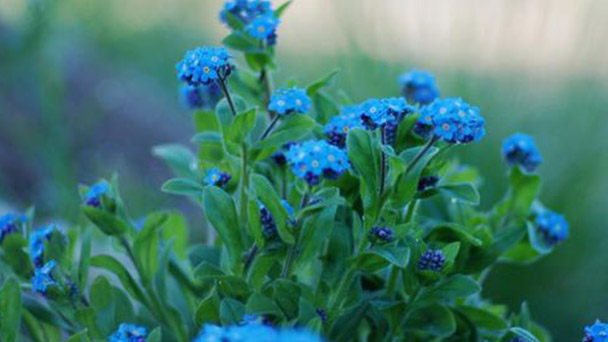Myosotis Sylvatica profile
Written by Maggie
Nov 23 2020

Myosotis Sylvatica is of Eurasian origin. Leaves are alternate, narrowly oblanded or striate. It likes sunlight and is shade tolerance, easy to sow reproduction.The flowers of Myosotis Sylvatica are small and beautiful, with a yellow heart in the center of the blue flower, striking and harmonious with colors, especially the corymbose inflorescence gradually lengthening with the opening of the flower, half containing, charming and unforgettable.
Myosotis Sylvatica picture

Morphological characteristics of Myosotis Sylvatica
Myosotis Sylvatica is a perennial herb. Stems are erect, single or fascicled, 20-45 cm tall, usually branched, sparsely spreading strigose, sometimes curly. It has basal leaves and lower stems sessile, narrowly oblanceolate, oblong-lanceolate or linear-lanceolate, up to 8 cm long, 5-12 mm wide, apex rounded or slightly acute, base tapering, descending into wings, strigose on both surfaces, base with small basal platelets. Stems are above middle leaves sessile, shorter and narrower. Inflorescence is short in flowering, elongate after flowers, up to 15 cm long, ebracteate. Pedicels are coarser, erect in fruit, 4-6 mm long, as long or slightly longer than calyx, densely pubescent. Calyx is 1.5 -- 2.5 mm, fruited acuminate, 4 -- 5 mm long, deeply divided to 2/3 to 3/4 of calyx length, lobes lanceolate, apically acuminate, densely extended or hooklike. Corolla is blue, 6 -- 8 mm in diam., tube ca. 2.5 mm long, lobes 5, suborbicular, ca. 3.5 mm long, laryngeal appendages 5, ca. 0.5 mm high. Anthers are elliptic, apex with rounded appendages.Nutlets are ovate, ca. 2 mm long by 1 mm wide, dark brown, smooth, glossy, surrounded by narrowly edged but apically conspicuous, base without appendage.

Growth habits and distribution of Myosotis Sylvatica
[Growth habit] Myosotis Sylvatica has strong adaptability, and likes dry and cool climate, hates humidity and heat. Iikes light and is drought tolerant, and the suitable temperature for growth is 20-25 °C.It is uitable for growth in loose, fertile, well-drained micro alkaline soil.
【 Distribution area】 Myosotis Sylvatica is distributed in Europe, Iran, Russia, Pakistan, Kashmir, India, and China's jiangsu province, northwest, north, northeast, sichuan, yunnan and other places, growing within 200 meters to 4200 meters, more than in broad-leaved forest margins, hillsides, forests and grass valley, yet by artificial cultivation.
Myosotis Sylvatica breeding method
Myosotis Sylvatica was used for seeding propagation and tissue culture. Sowing is usually in September and January of the following year. The seeds are light-sensitive and should be slightly covered with soil to maintain humidity after sowing. Germination was carried out at a temperature of 15-20 ℃ for 10 ~ 15 days. The temperature of sowing should not exceed 25℃, the germination should be ventilated after being unearthed, and the seedlings should be colonized with more than 5 true leaves.Tissue culture seedlings cultivated by tissue culture technology were transplanted with 4 ~ 6 leaves.

Myosotis Sylvatica's common variety
Common ornamental species:
1. The Myosotis sylvatica.
2. The Myosotis alpestris.
Wild species:
1.Myosotis Caespitosa; 2. The Myosotis bothriospermoides; 3. The Myosotis sparsiflora; 4. Myosotis sylvatica.
Latest Updated
- Benefits of Bugleweed - 7 Science-backed Health Benefits
- Bugleweed Dangers & Side Effects - Is It Poisonous?
- How to Plant Evergreen Trees - What You Should Know
- When to Plant Evergreens - Grow Guide for Evergreen Trees
- 12 Wonderful Evergreen Shrubs for Your Garden
- 12 Popular Evergreen Plants with Pictures for Beginners
- When And How To Prune A Lilac Bush Like a Pro
- How to Grow & Care for Lilac Vine (Hardenbergia Violacea)
- Japanese Lilac Tree (Syringa Reticulata) Care & Propagation Guide
- Shumard Oak Pros and Cons - What to Know
Popular Articles
- Winter maintenance of Antirrhinum Majus
- How to Grow Terminalia Mantaly Tree
- How to Grow and Care for Crossostephium Chinense
- How to grow Antirrhinum Majus in spring
- Peristeria Elata (Dove Orchid) Profile: Info & Care Guide
- Underwatered Snake Plant (Sansevieria Trifasciata) - Signs And How To Fix
- How to Care for Brazilian Jasmine Plant (Mandevilla Sanderi)
- How to Grow & Care for Graptopetalum Purple Delight in Summer
- Rosa Chinensis (China Rose): Plant Growing & Care Tips
- How to Care for Baby Sun Rose (Aptenia Cordifolia)